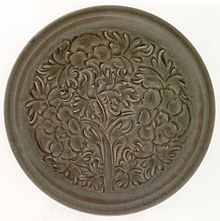Decorative arts
[citation needed] A similar fate has befallen tapestry, which late medieval and Renaissance royalty regarded as the most magnificent artform, and was certainly the most expensive.The Pattern and Decoration movement in New York galleries in the 1980s, though short-lived, opened the way to a more inclusive evaluation of the value of art objects.[citation needed] The promotion of the fine arts over the decorative in European thought can largely be traced to the Renaissance, when Italian theorists such as Vasari promoted artistic values, exemplified by the artists of the High Renaissance, that placed little value on the cost of materials or the amount of skilled work required to produce a work, but instead valued artistic imagination and the individual touch of the hand of a supremely gifted master such as Michelangelo, Raphael or Leonardo da Vinci, reviving to some extent the approach of antiquity.This aesthetic movement of the second half of the 19th century was born in England and inspired by the writings of Thomas Carlyle, John Ruskin and William Morris.According to Colin Campbell in his piece “The Craft Consumer”,[8] this is done by selecting goods with specific intentions in mind to alter them.






Le Nove porcelainsoft-paste porcelainCross of Lothairdesignbeautifulinterior designarchitectureCeramic artmetalworkfurniturejewelleryfashiontextile artsglasswareApplied artsfine artspaintingdrawingphotographysculptureaesthetic qualityintellectMughalNational Museum, New DelhirenaissanceIslamic artgeometricplant formsChinese artMedieval artEuropemanuscript illuminationmonumental sculpturegoldsmithivory carvingmosaictapestryNorthern Song DynastyceladonAmy GoldinPattern and DecorationVasariHigh RenaissanceMichelangeloRaphaelLeonardo da VinciMiddle Agesink wash paintinglandscapesscholar-bureaucratsChinese ceramicsArts and Crafts movementThomas CarlyleJohn RuskinWilliam MorrisArthur Heygate MackmurdoCopyright Act 1911mass productionconsumerismlifestylecustomizeddecoupageart carstruck art in South AsiaAmerican craftArt Nouveau in MilanArt for art's sakeDesign museumFaux paintingHistory of decorative artsIndustrial designLoewe Foundation Craft PrizeOrnament (architecture)TaschenUniversity of Wisconsin–MadisonChipstone FoundationMetropolitan Museum of ArtNational Gallery of ArtMobilier NationalMuseum of the City of New YorkNational Museum of Decorative Arts, Buenos AireshandicraftHistoryTextileBanner-makingCrochetingCross-stitchEmbroideryFeltingFriendship braceletKnittingLace-makingMacrameMillineryNeedlepointNeedleworkPatchworkQuiltingRibbon embroideryCarpetRug hookingRug makingSewingShoemakingSpinningString artTattingTie-dyeWeavingAltered bookBookbindingCalligraphyCardmakingCast paperCollagePapier colléPhotomontageIris foldingKamikiriOrigamiKirigamiMoneygamiEmbossingMarblingPapercraftPapercutting